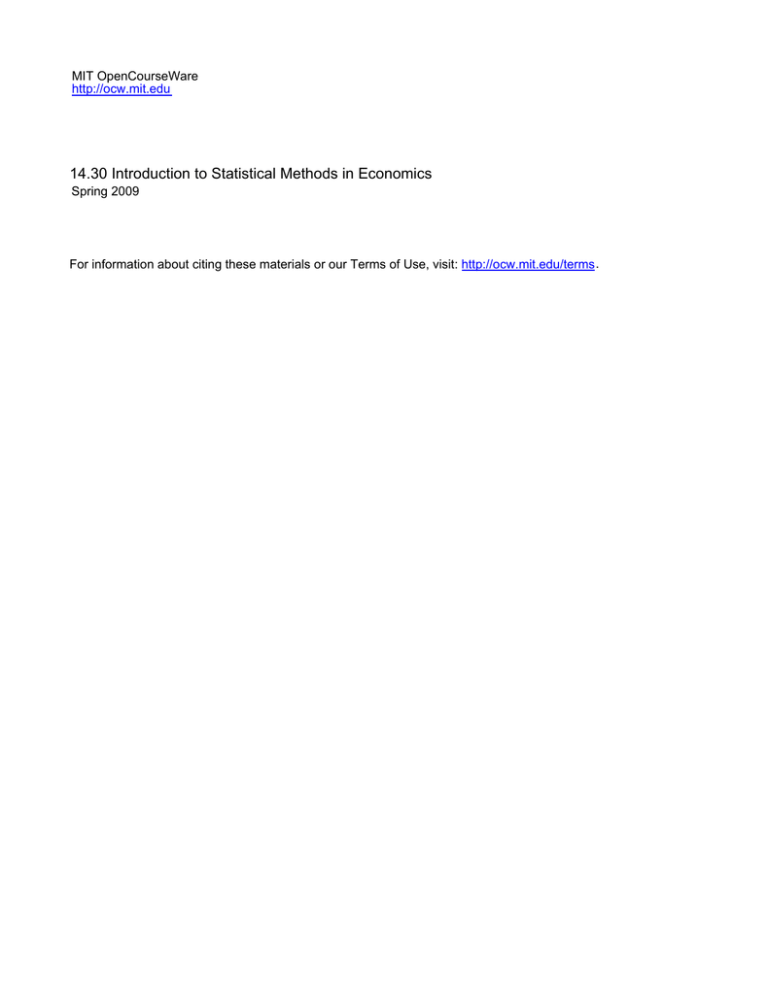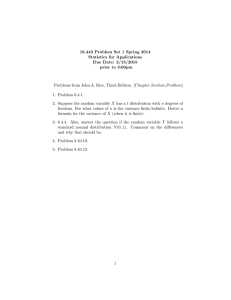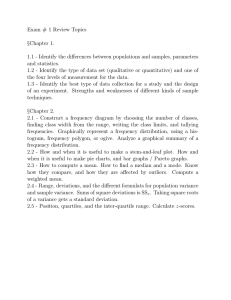14.30 Introduction to Statistical Methods in Economics
advertisement

MIT OpenCourseWare
http://ocw.mit.edu
14.30 Introduction to Statistical Methods in Economics
Spring 2009
For information about citing these materials or our Terms of Use, visit: http://ocw.mit.edu/terms.
Problem Set #7
14.30 - Intro. to Statistical Methods in Economics
Instructor: Konrad Menzel
Due: Tuesday, April 14, 2009
Question One
We just learned about the standard Normal distribution with PDF 4(z) and CDF @(z).
Let's familiarize ourselves with it, as we will be using it a lot in the future.
1. Find u
= @(z)for
z = (-3, -2.5, -2, -1.5, -1, -0.5,0,0.5,1,1.5,2,2.5,3).
2. Find u = 1 - Pr(lZ1 5 z) for z = {0,0.5,1,1.5,2,2.5,3) using your answers from part
(1). Explain (via math or words) how you obtained your answers. We call these values
of u "p-values" which stands for "probability values" of a result at least that extreme
occuring. Memorize these seven values-you will certainly use them in the future.
3. Find z = @-I (u) for u = {0.001,0.005,0.01,0.02,0.05,0.10,0.20).
4. Use the results from part (3) to obtain z = W1(l - u) for each u.
<
5. Use the results and/or methods from part (3) and (4) to obtain z where 1- Pr(lZ1
z) = u for each u in part (3). These values of z are called the "two-sided a-level critical
values" where a = u in this example. For example, we say, "The (two-sided) 10%
critical value of the standard normal distribution is z = . . ." These will be useful in
the future. Memorize these seven values as well.
6. Finally, interlace (i.e. sort) the values of z and u in a short table with the 14 values of
z and u you obtained in parts (2) and (5). Start with z = 0 and p = 1 and put the z's
in the right order with their corresponding probabilities.
Question Two
1. Given a random variable X, define the standardization Z of X and derive its variance.
2. Suppose Xzo is the mean of a sample of n = 20 i.i.d. observations with Xi N(1,2).
What is the expected mean and variance of this average? What is its distribution
(Hint: see lecture notes, around Proposition 24)? What is the probability that the
sample mean xzois between 0.75 and 1.25?
N
3. In Pset #5, we used the convolution formula to determine the finite distribution of the
average (and sum) of k i.i.d. exponential random variables, noting that the mean did
not depend on the distribution. What is the variance of the sum of k i.i.d. random
variables? What's the variance of their average? We noticed (in the solution set to Pset
#5) that the average over the exponential RVs approaches the normal distribution. Do
you think that this property was specific to the exponential distribution?
Question Three
Suppose that a random sample of size n is taken from a normal distribution with mean p
and variance 3, and that the sample mean, X,, is calculated.
1. What does n need to be so that the probability of X, being within 0.1 of p is at least
go%?'
2. What does n need to be so that the probability of Xn being within 0.01 of p is at least
90%?
3. In my experiments at Yahoo!, I have been looking at treatment and control differences
to determine the effectiveness of online display advertising. The standard deviation of
(scaled) weekly sales is R$15.00 and average weekly purchases are R$1.00 for the control
group and R$1.00 +6 for the treatment group. If I am constrained to have only 25% of
my observations in the control group and the remaining 75% in the treatment group,
what is the variance of the difference between xT- xCwhere xTis the sample average
over all treatment individuals and xc is the average over all control individuals? How
large does N have to be in order for the probability of XT - XC > 0 is at least
95%? Assume the sample averages for the treatment and control groups are normally
distributed. Do this for general 6 and then evaluate it for 6 = R$0.05 and 6 = R$0.10.
Are these values of N large? Comment on the results.
Question Four
Use a table, calculator, internet, simulation, or any other method (besides cheating) to
determine the following critical values:
<
t distribution: 1 - P(IT1 t;dof) = 0.05 for dof
1. T
these compare to the 0.05 critical values of the Normal?
N
=
5, 10, 20, 30, 50. How do
Xg
2. X
distribution: P(X 2 x; k) = 0.05 for k = 1,2,3,4,5,100. How do these
compare to the 0.05 critical values of the Normal? (Hint: Divide by k and take the
N
lThese are what we call power calculations and help us craft surveys and experiments t o guarantee before
spending lots of money that we'll be able to detect economically meaningful effects, if they are present.
For example, we usually think of log wages as being normally distributed. Often times we need to know
how many observations we need in a survey for the average log wage to be close enough t o the true mean.
Further, as we will learn about the Central Limit Theorem, we'll realize that for any average that we might
be interested, for n 30, the distribution we sample from will generally not affect our calculation of n.
>
square root-kind of like an average. Focus on k = 1 and just compare the higher
degrees of freedom to the critical values of N(k, 2 . k).) A few of these may be worth
memorizing as well.
Question Five
What is the distribution of
where Yl xi, and Y2 x i Z ? What happens to the value
and variance of the denominator when when k2 + oo? (Hint: What is the sum of two
i.i.d. Xf random variables? Then, what's the variance of their average? And how about the
sum and average of k2 of them?) What distribution do you think that means that the ratio
converges to (holding kl fixed)?
N







